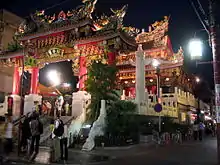Yokohama Chinatown
Yokohama Chinatown (Japanese: 横浜中華街, Hepburn: Yokohama chūkagai) is located in Yokohama, Japan, which is located just south of Tokyo. Its history is about 160 years long. Today, only a few Chinese people still live in Chinatown, but it has a population of about 3,000 to 4,000. Most of the residents are from Guangzhou (Canton), but many come from other regions.




Yokohama Chinatown is the largest Chinatown in Japan (larger than Chinatowns in both Kobe and Nagasaki) and it is one of the largest in the world. There are roughly 250 Chinese-owned or themed shops and restaurants scattered throughout the district, with the highest concentration centered on a 300 m2 (3,200 sq ft) area.
History
In 1859, when the sea port opened in Yokohama, many Chinese immigrants arrived in Japan and formed settlements. Later, ferry services from Yokohama to Shanghai and Hong Kong were started. Many Chinese traders came to Japan and built a Chinese school, Chinese community center, and various other facilities in what represented the beginning of Chinatown. However, government regulations at the time meant that immigrants were not permitted to live outside of the designated foreign settlement area. In 1899, new laws gave Chinese increased freedom of movement while reinforcing strict rules on the types of work Chinese people were allowed to perform.
In 1923, the Kanto Area was devastated by the Great Kantō earthquake. Around 100,000 people were killed and approximately 1.9 million people became homeless. Chinatown also suffered and many immigrants chose to return to China instead of rebuilding their lives in Yokohama.
In 1937, full-scale war between China and Japan erupted, effectively stopping further growth of Chinatown. After the war ended, Chinatown once again began to grow. In 1955, a large goodwill gate was built. That is when the Chinatown was officially recognized and called Yokohama Chukagai (Yokohama Chinatown).
In 1972, Japan established diplomatic relations with the People's Republic of China, and severed relations with the Republic of China on Taiwan. Interest among Japanese people grew and led to an explosion in the number of visitors to Chinatown. It soon became a major sightseeing spot in Yokohama.
On February 1, 2004, the Minatomirai Line railway was opened, along with the Motomachi-Chūkagai Station, which serves Chinatown directly.
Transportation
Chinatown can be reached by train, bus, seabus and car.
Train
- Minatomirai Line, Motomachi-Chūkagai Station (35 min from Shibuya Station in Tokyo)
- Negishi Line, Ishikawachō Station (50 min from Shinagawa Station in Tokyo)
Bus
There are 6 bus routes from Yokohama Station East bus depot and from Sakuragichō Bus Depot, 16 bus routes that go to Yokohama Chinatown.
Seabus
- Seabus (Ferry)
Highway
- Shuto Expressway K1 Yokohane Route, Yokohama Kōen (Yokohama Park) Exit
- Shuto Expressway K3 Kariba Route. (At Tomei Expressway Intersection, go Hodogaya Bypass then exit at Shin Yamashita.)
- Shuto Expressway Wangan Line (Via Tokyo Bay Aqua Line Tunnel, Exit at Shin Yamashita.)
- Tomei Expressway (Via Hodogaya Bypass)
See also
- Yokohama Ma Zhu Miao
- Chinatown
- Chinatowns in Asia
- Nankin-machi (“Nanjing Town” in Kobe)
- Nagasaki Shinchi Chinatown
- Chinese in Japan
- China
- Koreatowns in Japan
External links
| Wikimedia Commons has media related to Chinatown, Yokohama. |
- Yokohama Chinatown Official Website
- Kwan Tai Temple(in Japanese)
- Yokohama Chinatown Official Website (Japanese)
- City of Yokohama - Yokohama Sightseeing Spots Chinatown Area (English, Chinese, Japanese, Korean)
 Geographic data related to Yokohama Chinatown at OpenStreetMap
Geographic data related to Yokohama Chinatown at OpenStreetMap